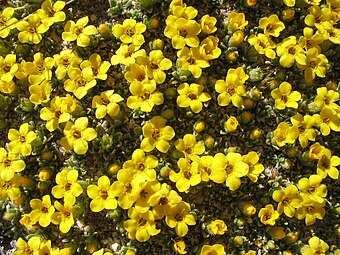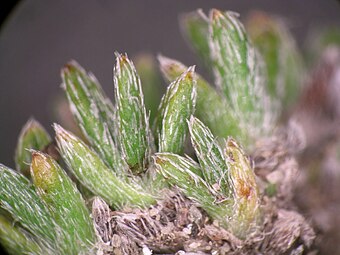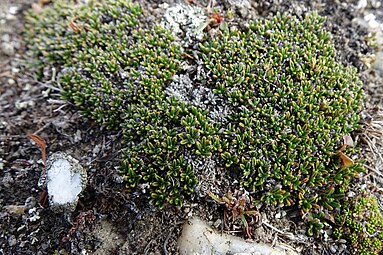| Myosotis uniflora | |
|---|---|

| |
| Myosotis uniflora cushion in full flower | |
| Conservation status | |
 Naturally Uncommon (NZ TCS) | |
| Scientific classification | |
| Kingdom: | Plantae |
| Clade: | Tracheophytes |
| Clade: | Angiosperms |
| Clade: | Eudicots |
| Clade: | Asterids |
| Order: | Boraginales |
| Family: | Boraginaceae |
| Genus: | Myosotis |
| Species: | M. uniflora |
| Binomial name | |
| Myosotis uniflora Hook.f. | |
Myosotis uniflora is a species of flowering plant in the family Boraginaceae, endemic to the South Island of New Zealand. Joseph Dalton Hooker described the species in 1867. Plants of this species of forget-me-not are perennial with a prostrate, compact, cushion or mat habit, short bracteate inflorescences, and cream to yellow corollas.
Taxonomy and etymology
Myosotis uniflora Hook.f. is in the plant family Boraginaceae and was described in 1867 by Joseph Dalton Hooker. It is morphologically most similar to the other two cushion- or mat-forming species, M. pulvinaris and M. glabrescens. Myosotis uniflora differs from these two species in its ecology and morphology, including its cream to yellow corollas; acute, lanceolate to ovate narrow (< 1.3 mm) rosette leaf lamina; and narrow petioles (< 1.2 mm wide).
The lectotype specimen of Myosotis uniflora is lodged at Kew Herbarium (K000787907). Two isolectotypes (K000787908 and K000787910) are also found on the same sheet as the lectotype, and a third isolectotype is at the Allan Herbarium of Manaaki Whenua - Landcare Research (CHR 97402).
The specific epithet, uniflora, is derived from Latin for 'one-flowered'.
Phylogeny
Myosotis uniflora was shown to be a part of the monophyletic southern hemisphere lineage of Myosotis in phylogenetic analyses of standard DNA sequencing markers (nuclear ribosomal DNA and chloroplast DNA regions). The two sequenced individuals of M. uniflora were near but not sister to each other in the nuclear ribosomal DNA phylogeny, grouping with other bracteate-prostrate species such as M. glauca and M. antarctica. Within the southern hemisphere lineage, species relationships were not well resolved.
Description
Myosotis plants are compacted cushions or mats that can reach 50 cm in diameter. The many imbricate rosette leaves have petioles 1–4 mm long that are glabrous but with erect hairs on the edges. The rosette leaf blades are 1–4 mm long by about 1 mm wide (length: width ratio 1.4–4.1: 1), lanceolate to ovate or triangular, widest at or below the middle, with an acute apex. The upper and lower surfaces of the leaf are sparsely to densely covered in long, flexuous, appressed to patent, antrorse (forward-facing) hairs that are oriented parallel to the mid vein. Each rosette has few prostrate to ascending, once-branched, bracteate inflorescences that are up to 60 mm long. The cauline leaves are similar to the rosette leaves but smaller. Each inflorescence has a solitary flower, borne on a short pedicel, with a bract. The calyx is 1–4 mm long at flowering and 2–5 mm long at fruiting, lobed to about half its length, and densely covered in long, antrorse, flexuous (rarely hooked at the calyx base), mostly appressed (few patent) hairs. The corolla is cream to yellow, 2–7 mm in diameter, with a cylindrical tube, petals that are obovate to very broadly obovate or ovate to very broadly ovate, and flat, and small yellow scales alternating with the petals. The anthers are usually fully included, or sometimes partially included with the tips only surpassing the scales. The four smooth, shiny, dark brown nutlets are 1.4–1.7 mm long by 0.8–1.4 mm wide and narrowly ovoid to broadly ovoid in shape.
The chromosome number of M. uniflora is unknown.
M. uniflora has M. uniflora type pollen. The breeding system of Myosotis uniflora is outcrossing, as the flowers are 'always herkogamous', with a high pollen : ovule ratio.
It flowers and fruits from September–March, with the main flowering period October–January and the main fruiting period November–March.
Gallery
Distribution and habitat

Myosotis uniflora is a forget-me-not endemic to the South Island of New Zealand in the ecological districts of Canterbury and Otago from 210–850 m ASL elevation. It is mainly found in Otago, but is also known from Westland, Canterbury and Fiordland from 1020–2130 m ASL. M. uniflora plants are found scattered throughout lowland river-bed flats and terraces, with other cushions, herbs and subshrubs. They are closely associated with cushionfield, moss-stonefield and stonefield plant communities in upper river catchments.
Conservation status
The species is listed as "At Risk - Naturally Uncommon" on the most recent assessment (2017-2018) under the New Zealand Threatened Classification system for plants, with the qualifiers "Sp" (Sparse) and "DP" (Data Poor).
References
- ^ Lange, Peter J. de; Rolfe, Jeremy R.; Barkla, John W.; Courtney, Shannel P.; Champion, Paul D.; Perrie, Leon R.; Beadel, Sarah M.; Ford, Kerry A.; Breitwieser, Ilse; Schönberger, Ines; Hindmarsh-Walls, Rowan (May 2018). "Conservation status of New Zealand indigenous vascular plants, 2017" (PDF). New Zealand Threat Classification Series. 22: 45. OCLC 1041649797.
- ^ Hooker, Joseph Dalton (1867). Handbook of the New Zealand flora : a systematic description of the native plants of New Zealand and the Chatham, Kermadec's, Lord Auckland's, and Macquarrie's islands. London: Reeve & Co. p. 193.
- ^ Moore, L.B. "Boraginaceae. In 'Flora of New Zealand'. (Ed. HH Allan) Vol. 1, pp. 806–833". (Government Printer: Wellington, New Zealand) floraseries.landcareresearch.co.nz. Retrieved 27 April 2022.
- "Myosotis uniflora". New Zealand Plant Conservation Network. Retrieved 22 June 2022.
- ^ Meudt, Heidi M.; Prebble, Jessica M. (28 February 2018). "Species limits and taxonomic revision of the bracteate-prostrate group of southern hemisphere forget-me-nots (Myosotis, Boraginaceae), including description of three new species endemic to New Zealand". Australian Systematic Botany. 31 (1): 48–105. doi:10.1071/SB17045. ISSN 1446-5701. S2CID 90834744.
- "Myosotis uniflora lectotype on JSTOR". plants.jstor.org. Retrieved 29 June 2022.
- "Myosotis uniflora". scd.landcareresearch.co.nz. Retrieved 29 June 2022.
- ^ Meudt, Heidi M.; Prebble, Jessica M.; Lehnebach, Carlos A. (1 May 2015). "Native New Zealand forget-me-nots (Myosotis, Boraginaceae) comprise a Pleistocene species radiation with very low genetic divergence". Plant Systematics and Evolution. 301 (5): 1455–1471. doi:10.1007/s00606-014-1166-x. ISSN 2199-6881. S2CID 254048318.
- Winkworth, Richard C; Grau, Jürke; Robertson, Alastair W; Lockhart, Peter J (1 August 2002). "The origins and evolution of the genus Myosotis L. (Boraginaceae)". Molecular Phylogenetics and Evolution. 24 (2): 180–193. doi:10.1016/S1055-7903(02)00210-5. ISSN 1055-7903. PMID 12144755.
- Meudt, HM (1 October 2016). "Pollen morphology and its taxonomic utility in the Southern Hemisphere bracteate-prostrate forget-me-nots (Myosotis, Boraginaceae)". New Zealand Journal of Botany. 54 (4): 475–497. doi:10.1080/0028825X.2016.1229343. ISSN 0028-825X. S2CID 89118799.
- Robertson, A. W.; Lloyd, D. G. (1991). "Herkogamy, dichogamy and self-pollination in six species of Myosotis (Boraginaceae)". Evolutionary Trends in Plants. ISSN 1011-3258.
- Woolmore, CB (2011). The Vegetation of Braided Rivers in the Upper Waitaki Basin: South Canterbury, New Zealand (PDF). Christchurch, New Zealand: Department of Conservation, Canterbury Conservancy. pp. 1–67. ISBN 978-0-478-14881-7.
External links
- Myosotis uniflora occurrence data from Australasian Virtual Herbarium
- [REDACTED] Media related to Myosotis uniflora at Wikimedia Commons
| Taxon identifiers | |
|---|---|
| Myosotis uniflora | |



